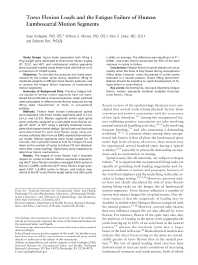Mining Publication: Torso Flexion Loads and Fatigue Failure Mode of Human Lumbosacral Motion Segments
Original creation date: January 2005
Spine loads associated with lifting a 9-kg weight were estimated at three torso flexion angles (0, 22.5, and 45 deg), and lumbosacral motion segments were cyclically loaded using these loads until failure or to a maximum of 10,020 cycles. The objective was to simulate the postures and loads experienced by the lumbar spine during repetitive lifting of moderate weights in different torso flexion postures and to analyze the fatigue failure response of lumbosacral motion segments. Previous fatigue failure studies of lumbar motion segments have not reproduced the combination of spinal postures, loads, and load rates anticipated in different torso flexion postures during lifting tasks characteristic of those in occupational settings. Twelve fresh human lumbosacral spines were dissected into three motion segments each (L1-L2, L3-L4, and L5-S1). Motion segments within each spine were randomly assigned to a simulated torso flexion angle (0, 22.5, or 45 deg) using a partially balanced incomplete block experimental design. Spinal load and load rate were determined for each torso flexion angle using previously collected data from an EMG-assisted biomechanical model. Motion segments were creep loaded for 15 minutes, then cyclically loaded at 0.33 Hz. Fatigue life was taken as the number of cycles to failure (10-mm displacement after creep loading). Specimens were inspected to determine failure mechanisms. The degree of torso flexion had a dramatic impact on cycles to failure. Motion segments experiencing the 0-deg torso flexion condition averaged 8,253 cycles to failure (+/-2,895), while the 22.5-deg torso flexion angle averaged 3,257 (+/-4,443) cycles to failure, and motion segments at the 45-deg torso flexion angle lasted only 263 cycles (+/-646), on average. The difference was significant at P<0.0001, and torso flexion accounted for 50% of the total variance in cycles to failure. Fatigue failure of spinal tissues can occur rapidly when the torso is fully flexed during occupational lifting tasks; however, many thousands of cycles can be tolerated in a neutral posture. Future lifting recommendations should be sensitive to rapid development of fatigue failure in torso flexion.
Authors: S Gallagher, WS Marras, AS Litsky, D Burr
Peer Reviewed Journal Article - January 2005
NIOSHTIC2 Number: 20028583
Spine 2005 Oct; 30(20):2265-2273
See Also
- The Availability of Primary Copper in Market Economy Countries: A Minerals Availability Appraisal
- CFD Analysis of Mine Fire Smoke Spread and Reverse Flow Conditions
- A Comparison of Fatigue Failure Responses of Old Versus Middle-Aged Lumbar Motion Segments in Simulated Flexed Lifting
- Effects of Lifting in Four Restricted Postures
- Effects of Posture on Dynamic Back Loading During a Cable Lifting Task
- Electromagnetic Noise in Itmann Mine
- Methane Emission Rate Studies in a Northern West Virginia Mine
- Seismic Event Data Acquisition and Processing: Distribution and Coordination Across PC-Based Networks
- Task Analysis
- Technology News 521 - Development of a Mobile Manipulator to Reduce Lifting Accidents
- Content source: National Institute for Occupational Safety and Health, Mining Program


 ShareCompartir
ShareCompartir
